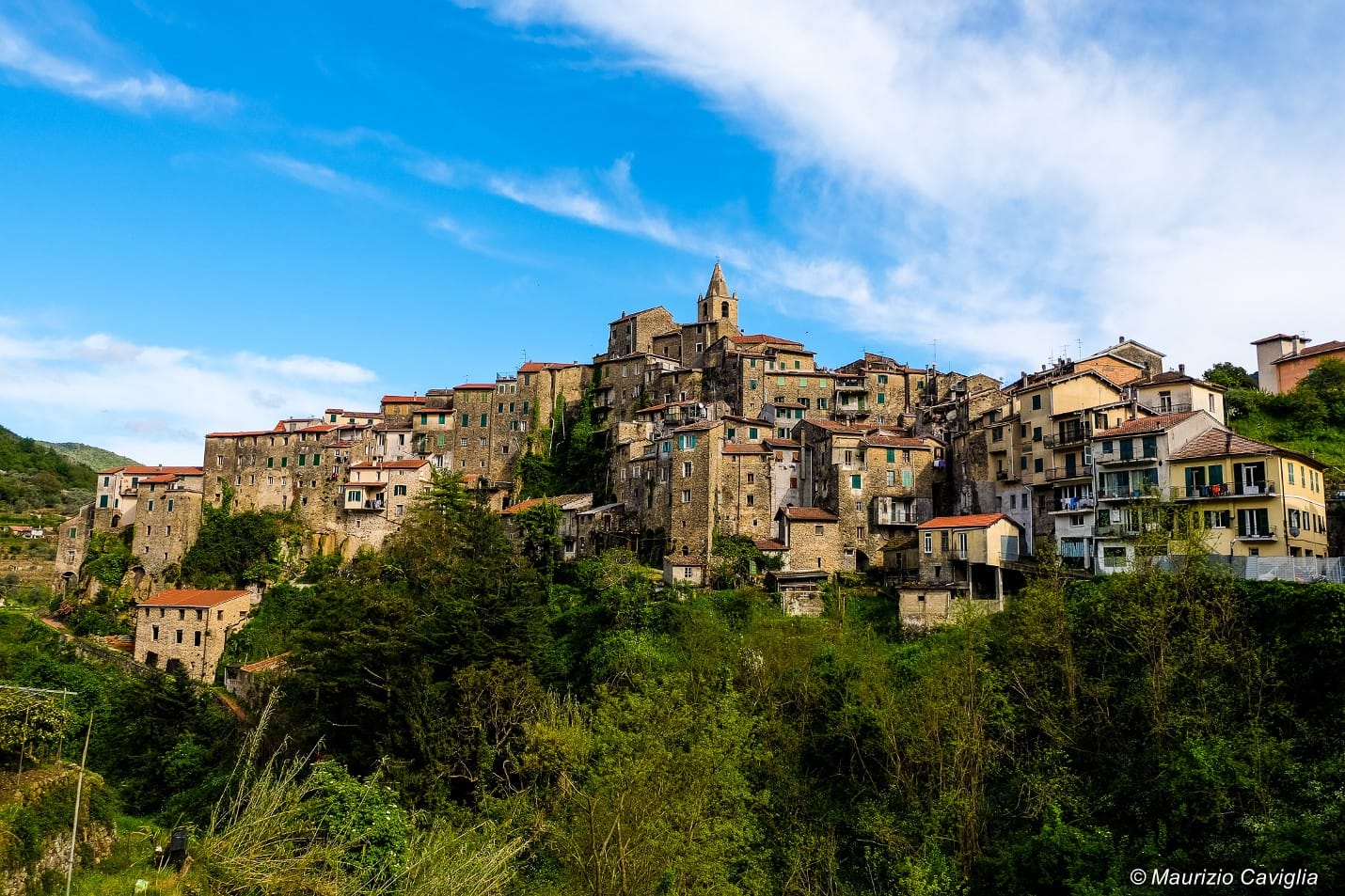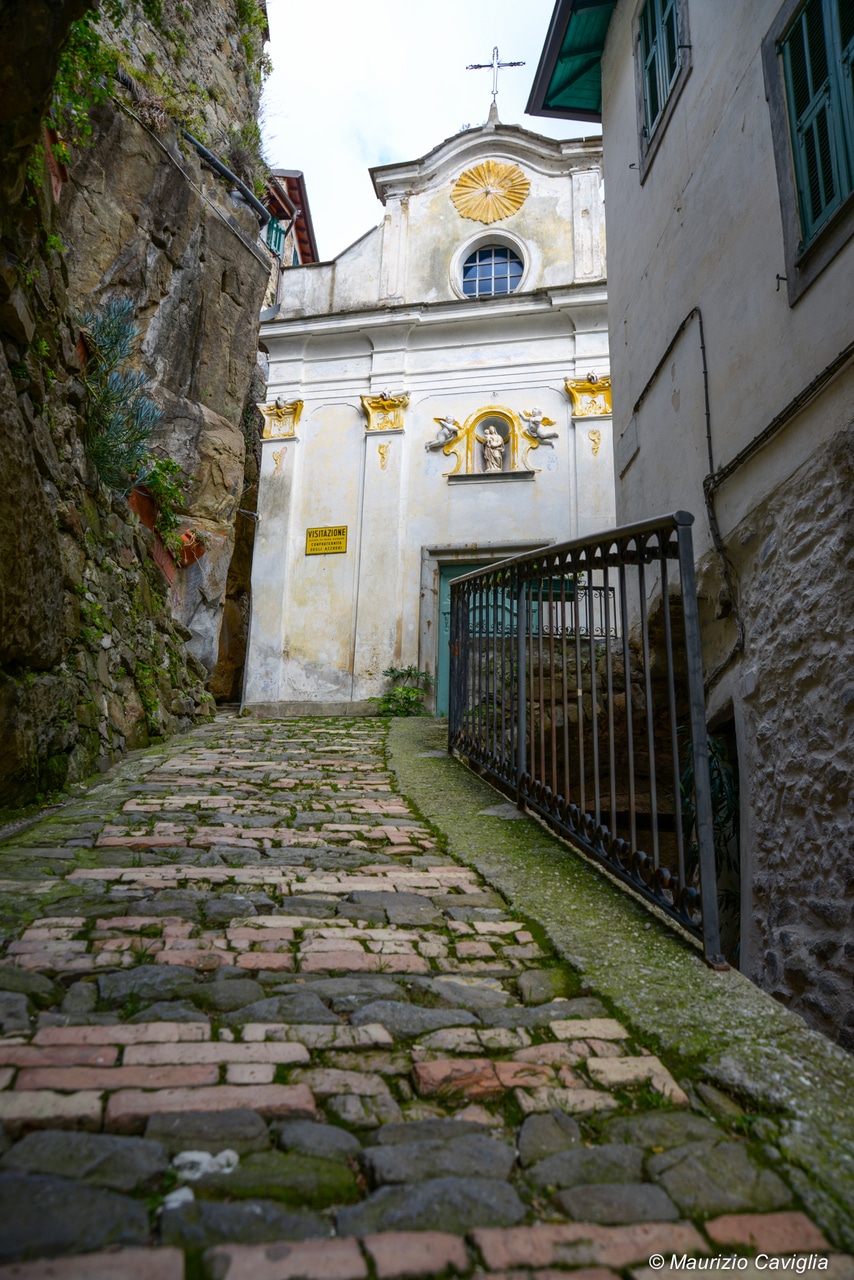The descent of the Via Celio leads to the Church Oratory of the Visitation, where the Confraternity of the Azzurri meets. The church leans against a gateway to the Castrum. Inside, the marble altar, the vault decorated by Maurizio Carrega and the eighteenth- and nineteenth-century canvases provide a breathtaking choreography.
From the far corner of Piazza Rubini, the visitor enters Via Visitazione “U camin cian.” All of a sudden, enclosed between the houses, a glimpse of the baroque facade of the oratory appears. The architectural reality of the oratory is the original one, the result of an initiative perhaps as early as the 15th century; it would be rearranged in the second half of the 1600s and enriched over the next two centuries.
The church of the Visitation, as if set between the rocky crag, the peňa, and the palaces of ancient nobility, is located close to the medieval wall line, at the edge of the ancient settlement, right on one of the gates to the castrum coelianae. The building seems to be an integral part of the city’s defensive system: evidence of this is the trapdoor created on the floor of the sacristy, immediately above one of the castrum gates: it allowed control of the pass.
From the gathered little square in front, the carved stone portal contains the finely carved blue doorway, through which one enters the striking rectangular hall, illuminated by windows veiled in blue fabric that give soft light to the entire church. Passing through two wings of wooden stools, one reaches the marble altar complex (1729), depicting Our Lady’s visit to St. Elizabeth.
Gio Andrea Mazzetti conceived a beautifully crafted altar machine, with twisted alabastrine columns, Corinthian capitals around the statues of the Saints, flanked by statues of St. Joseph and St. Zacharias. The apse basin is redolent with frescoes, stucco work and gilding; the statues placed along the entire wall perimeter recall Marian symbolism and are attributed to the work of Adami and his workshop.
Surely among the inspirers of the ambitious decorative and figurative project stands a learned consultant, since all the themes of Maurizio Carrega’s frescoes (1784), which appear on the vault, refer to the enhancement of Mary’s role as a necessary element for intercession between humanity and God: the Virgin in Glory, accompanied by Her household, the Ark of the Covenant supported by Angels, and episodes from the Old Testament depicting strong and admirable women. On the right is a canvas depicting St. Sebastian, St. Dominic and St. Bartholomew.
The processional case re-proposes the meeting of St. Elizabeth and the Madonna, (1900) due to E. Bastianello, placed in the niche carved in the perimeter walls, from which an opening lets a suggestive blue light filter in; in the other niche on the same wall, the wooden processional statue of St. Bartholomew is placed on the mensa, which presents in the antependium the relief figure of St. Mary Magdalene, from the disappeared chapel of St. Mary Magdalene and St. Francis, as well as the canvas to the left of the entrance door, depicting St. Francis in ecstasy.
The oil-painted panel painting (1611) on the right side wall, showing the scene of the Visitation flanked by some Saints, was the main image of the oratory before the arrival of the statuary complex. But the most significant canvas, coming from the destroyed church of San Rocco, present in the oratory of the Azzurri is surely the one by Bernardo Castello from the first decades of the 17th century, just restored by M. Teresa Donetti: “The Ascension of the Virgin among Saints and Commissioners.” Around the Virgin, there are depictions of her attributes taken from the Lauretan Litanies and the Office of the Blessed Virgin: the cedar of Lebanon, the morning star, the ivory tower, the golden house, the olive tree, the cypress tree, the lily; while at her feet: effigies of St. Bartholomew, St. Roch, St. Francis, among angels and clouds, and portraits of aristocratic people with lots of ruffs.
Completing this precious casket is the marble floor with black and white geometric squares. The colors of the white, ochre and blue facade, the very name Pena (Peňa), and the characters depicted on the painting of the Virgin just described, could all hint at a link to the Spanish nation and identity of the 1600s. The ancient sound of the bellows organ, built by the Agati firm of Pistoia in 1856, still plays on special occasions. The archive preserves the account and membership book from 1662 (without chronological interruption), ancient missals.
The sacristy houses the baroque processional insignia (18th cent.): carved and painted tablets in blue, ivory and gold, bearing phrases pertaining to the Passion of Jesus, which were carried in Holy Week processions by children.
Children from the age of two up to First Communion still play an important role in the Holy Week processions: they carry the ancient instruments of the Passion, once placed on the “Cross of Flags,” adorned with a blue bow, the same bow that adorns their white dress. The Patron Saint is traditionally celebrated on July 2: Mass at 11 a.m., then the evening procession at 8 p.m., preceded by the singing of Vespers and the inscription of new Brothers. A small concert by the Musical Band concludes the ceremony.
It has become customary to celebrate the closing Holy Mass of the Marian month and the cycle of the children’s “Little Churches” Masses at the Visitation Oratory, thus also celebrating the liturgical anniversary of May 31. The feast day of St. Bartholomew is August 24.
A proverb of ancient peasant knowledge quotes, “A San Bertuméi a veglia a se mete en péi,” alluding to the days becoming shorter every day.
comuneceriana.im@legalmail.it



